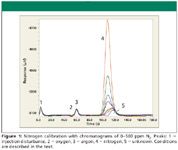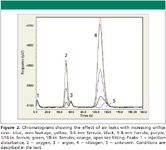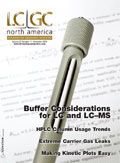Extreme Leaks
LCGC North America
In this month's "GC Connections," John Hinshaw investigates how much air enters a gas stream in the face of extreme leaks in an attempt to gauge the potential effects of carrier gas leaks on GC system performance.
Leaks are anathema to chromatographers. Wasteful of ever more scarce and expensive gas or liquid mobile phase, leaks have been blamed for detector noise, baseline instability, inaccurate flow calibration, column degradation, and potential explosion or toxicity hazards. Conventional laboratory wisdom states that any leak is to be avoided, even trace leaks that don't materially affect flow measurements or gas consumption.
In gas chromatography (GC), the gas supply lines are bathed in a mixture of 78% nitrogen, 21% oxygen, and 0.9% argon, plus some water and a smattering of trace-level gases, which is to say, room air. Room air can flow or diffuse past a leaky fitting, diaphragm, or seal into regulators, supply lines, and inlets, so the potential exists for oxygen and water to enter carrier gas lines through poorly made-up fittings, permeable regulator diaphragms, or leaking septa. The result: expensive, high-purity 99.9999% carrier gas gets downgraded to something less pure. Good laboratory practice calls for careful attention to fittings, checking for leaks with high-sensitivity electronic leak detectors, the use of appropriately rated high-purity gas regulators and valves, and regular septum and inlet seal replacement. Installation of gas filters that trap oxygen, hydrocarbons, and moisture is highly recommended as a stop-gap measure against the traces of contamination that might make their way into the carrier gas despite all the other precautions.
The effects of gas impurities are relative to the sensitivity of the instrumentation and columns to the contaminants. Some capillary GC columns — the "wax" types for example — can degrade rapidly in the presence of sub-part-per-million (<10-6 volumetric concentration) levels of oxygen when operated at elevated temperatures. Certain detection methods, such as flame ionization detection (FID), are not sensitive to air contamination but they are quite sensitive to the hydrocarbon content of their fuel gases. Other detection methods, such as discharge ionization detection (DID), are exquisitely sensitive to contaminants. Gas sampling valves for very high sensitivity work can require various purge arrangements that flood the valves with carrier gas externally as well as internally to prevent even the slightest influx of air into the active valve passageways. The fact that it is necessary to resort to such measures clearly demonstrates the significance of extremely small gas leaks.
For this installment of "GC Connections," I measured the extent of air incursion against some extremely large gas leaks. I had to resort to very large leaks to see any effects because I was not using very sensitive equipment, just a conventional GC system with thermal conductivity detection (TCD) that can only detect down to several parts per million of air in helium.
Contamination or Leakage?
Carrier gas leaks and poor quality carrier gas can yield similar problems: They both cause contaminants to enter the column and detector. In the course of investigating issues with carrier gas quality I wondered, how much air does enter a carrier gas line against a detectable leak? The concept of air flowing into a fitting against the outward flow of exiting carrier gas seems counterintuitive; could this really happen?
Recently. I investigated what apparently were several locally sourced cylinders of contaminated ultrahigh purity (UHP) helium that had been installed on a group of process analyzers in a remote area halfway around the world from my location in the western U.S. A little experimentation in the laboratory with a test analyzer quickly revealed that the helium carrier gas in the remote analyzers seemed to contain something like 1000 ppm of nitrogen, orders of magnitude more than the 1 ppm or less that should have been present. But this finding left open the question of the origin of the contaminating nitrogen: Was it in the cylinders themselves or had it entered the carrier gas downstream from the cylinders due to a leak or a defective seal? All the evidence pointed to poor quality cylinders. The rates of gas consumption were normal, no leaks were evident when examined during a service visit, high-purity gas regulators had been installed, and the side effects of the contamination were very similar for each of the analyzers. If leaks were involved, then it seemed unlikely that the leakage would be nearly the same for each of three independent analyzers with their own individual carrier gas tanks.
A quick experiment further exonerated any reasonable leakage as a source of nitrogen contamination. With no carrier gas filters in place, I simply loosened the carrier gas bulkhead fitting on the laboratory test system until a large leak could be detected with a handheld electronic leak detector set on its low sensitivity range. This had no effect on the chromatography and did not produce the characteristic baseline-upset symptoms of high levels of nitrogen contamination. I went even further and loosened the carrier gas fitting enough to cause an audible hiss as the gas escaped. At this leak rate, the cylinder pressure dropped from around 2300 psig (15.8 mPa) to 2150 psig (14.8 mPa) in 2 h, which would have emptied the tank in short order. Yet, no noticeable effects were seen in the chromatography. The resulting nitrogen contamination in the carrier, if any, was nowhere near 1000 ppm.
This left me wondering: Just how much air does move into the carrier gas stream against an outgoing leak, and how much does the air influx depend upon the size of the leak? As I thought about it, I recalled an inadvertent but similar result from an earlier "GC Connections" installment (1). At that time, I had been looking into carrier leaks inside a GC system and had found an incorrectly assembled and leaky bulkhead fitting at the back of the instrument. Repairing the fitting had no effect on the chromatography back then, either. In that case, the leak was found in the column inlet.
Measuring Leaks
At this point, I decided to quantify how much air (as nitrogen) would leak into the gas line as a function of the size of an orifice from which gas was free to leak out and air to flow back in against the leak. I installed a freshly conditioned 2.0 m x 1.0 mm 100/120 mesh micropacked molecular sieve 5A column (Supelco, Bellefonte, Pennsylvania) on a PerkinElmer (Shelton, Connecticut) AutoSystem XL GC system along with a six-port rotary gas-sampling valve (VICI, Houston, Texas) and 1.0-mL sample loop, all configured for conventional gas sample injection. The sample gas source was connected to the sample loop input through a 1/8-in. tee fitting followed by a solenoid on–off valve, and I connected a 1-m length of 0.5-mm i.d. stainless steel tubing to the rotary valve sample output to stop air from diffusing back up into the valving and loop while the loop pressure was allowed to decay to room pressure, before injection. The thermal conductivity detector was set to its highest sensitivity. A cylinder of UHP helium carrier gas already had been set up on the GC system. The oven temperature was set to 50 °C and the carrier pressure to 40 psig, which gave a column flow rate of 11.2 sccm. The system was stabilized at these settings for 12 h before proceeding.
Next I calibrated the detector response by feeding the output from an Environics (Tolland, Connecticut) model 4020 gas dilution system to the sample loop via a back-pressure regulator and gas take-off arrangement at a constant pressure of 30 psig. This produced a flow rate through the sample loop of around 500 sccm, which was more than sufficient to flush the connecting tubing and loop thoroughly. A second cylinder of certified UHP helium carrier gas was mixed by the dilution system with varying flows of 5000 (±2%) N2 in UHP helium from a gas standard cylinder (Scott Gas, Longmont, Colorado) to produce N2 concentrations of zero and then seven concentration steps from 6 to 500 ppm. Figure 1 illustrates the calibration chromatograms across the injected range. The calibration curve had a linear regression coefficient of r2 = 0.9991, with a zero intercept of +320 µV-s due to the constant unknown peak under N2, as can be seen in Figure 1 (peak 5). This extra peak may be krypton but I had no ready source with which to confirm its identity. The oxygen and nitrogen peaks were slightly negative with the pure UHP helium diluent, which indicated that the carrier gas contained roughly the same amounts of these gases as the diluent gas. With TCD, it was not possible to better discern such low levels.

Figure 1
Then, to determine the effects of varying the size of a major leak on nitrogen levels in helium carrier gas, I replaced the gas connection from the dilution apparatus with a connection to a third UHP helium cylinder using a different regulator as well. First, I obtained a few chromatograms with no leaks present, which were identical to the zero-level chromatograms from the gas dilution system. Then I performed some initial leak tests with the helium source at 40 psig (350 kPa). I created various leaks by loosening the sealed 90° side connection on the tee fitting in stages. First, the fitting was loosened just enough to get a significant reading on the helium leak detector. Then it was opened a bit more, and then finally to the point of creating an audible leak. Yet, none of these chromatograms were significantly different than those obtained with no leaks. This finding is consistent with the observation on the process analyzer in the laboratory that creating a large leak did not affect the chromatography in comparison to knowingly introducing contaminated carrier gas. It also is consistent with the earlier observation that a leaking bulkhead fitting was not the cause of characteristic baseline disturbances on a different system.
The Mythbuster Test
Most of the readers of LCGC North America are familiar with the "Mythbusters" television show. The hosts address an urban legend by attempting to recreate conditions that lead to the alleged effect or result. If they cannot recreate the desired effect as documented, then they resort to ever-more extreme conditions and test to the point of a dramatic failure.
At this point, having shown in three different ways that detectable levels of air — detectable with TCD, that is — did not seem to enter the carrier gas line against some small and some extreme leaks that might normally be encountered in the laboratory, I wanted to find some conditions, any conditions, under which detectable levels of air would enter a gas line against an outgoing leak. I decided to perform a "Mythbuster" test, although there was no dramatic exploding endpoint, just the possibility of an empty gas cylinder and a little more helium in the laboratory air.
To do this, I first reduced the tank regulator output from 40 psig down to 4 psig (35 kPa), not only to reduce the outgoing helium flow, but also because I was about to install some very large holes in the gas line, which at the higher pressure would have emptied the tank in a matter of hours. Besides being very noisy. I opened the side fitting on the tee completely and measured the nitrogen level in the line. Then I installed open 1/8-in. stainless steel ferrules with an open nut to hold them in place. After measuring this nitrogen level, I replaced the ferrules with a series of 1/8-in. fitting sized capillary column graphite–Vespel ferrules having increasingly smaller hole sizes: 1/16-in., 0.8-mm, and 0.5-mm i.d. The nitrogen level was measured after 10 min of flow with each orifice size. Figure 2 shows the chromatograms from this series. Note the oxygen peak, absent from Figure 1, which confirms the presence of air.

Figure 2
These results are shown in Figure 3 as a plot of the observed nitrogen concentration against the approximate area of the orifice openings. A fairly linear relationship was found, considering that I didn't actually measure the orifice sizes and I didn't take any steps to ensure that the pressure was the same for each ferrule — it could have changed due to differing pressure drops across the tubing from the regulator to the openings as the flows changed. In any case, these results clearly show that air does flow back against an outward helium leakage flow. I didn't attempt to extrapolate to smaller orifices and flow rates, but there is a strong implication that even much smaller leaks can allow significant traces of air to enter a carrier gas stream. It should be possible to measure them with a more sensitive system. Bear in mind that here we are discussing levels well above 1 ppm, while true trace-level gas analyses run down to the parts-per-trillion (10-12 volumetric concentration) level where even the best seals can start to look like large leaks and where leak-free operation imposes an entirely different regimen.
Conclusion
I didn't run the tests to a point of dramatic failure — emptying an old tank of helium is pretty benign. But, this simple demonstration underscores the necessity for leak-free connections, high-purity regulators, and rigorous gas filtration for any GC system that is running at high sensitivities or using capillary columns. Air leaks are not the only source of contamination, of course, and especially with current trends in helium availability and cost, more attention to helium cylinder quality in some remote locations is warranted.
John V. Hinshaw
"GC Connections" editor John V. Hinshaw is senior Research Scientist at Serveron Corp., Hillsboro, Oregon, and a member of LCGC's editorial advisory board. Direct correspondence about this column to "GC Connections," LCGC, Woodbridge Corporate Plaza, 485 Route 1 South, Building F, First Floor, Iselin, NJ 08830, e-mail lcgcedit@lcgcmag.com. For an ongoing discussion of GC issues, visit the Chromatography Forum discussion group at www.chromforum.com.
References
(1) J. Hinshaw, LCGC North America21(1), 34–40 (2003). (http://chromatographyonline.findanalytichem.com/lcgc/data/articlestandard//lcgc/052003/45060/article.pdf
Analysis of PFAS in Milk by LC-MS/MS
May 15th 2025Dairy milk is one commodity that can be impacted by environmental contaminants, such as PFAS, so it is important to implement extensive, robust, and accurate testing. In this work, a sensitive and reliable method was developed for the analysis of PFAS in milk by LC-MS/MS at levels as low as 0.01 µg/kg.

.png&w=3840&q=75)

.png&w=3840&q=75)



.png&w=3840&q=75)



.png&w=3840&q=75)













